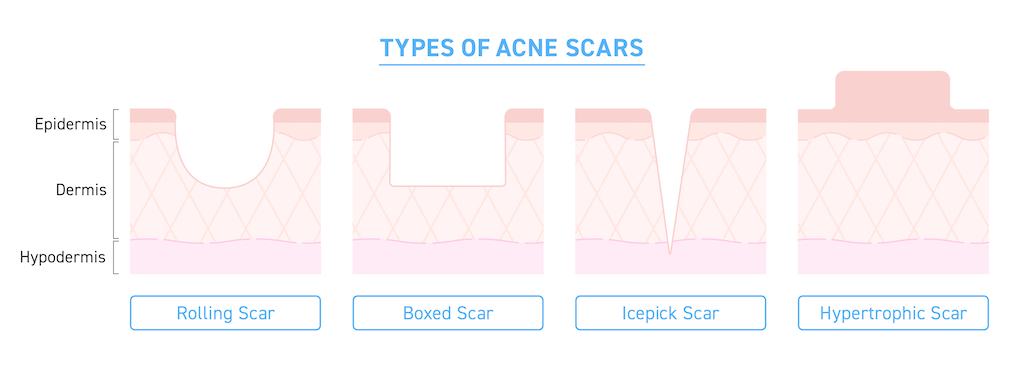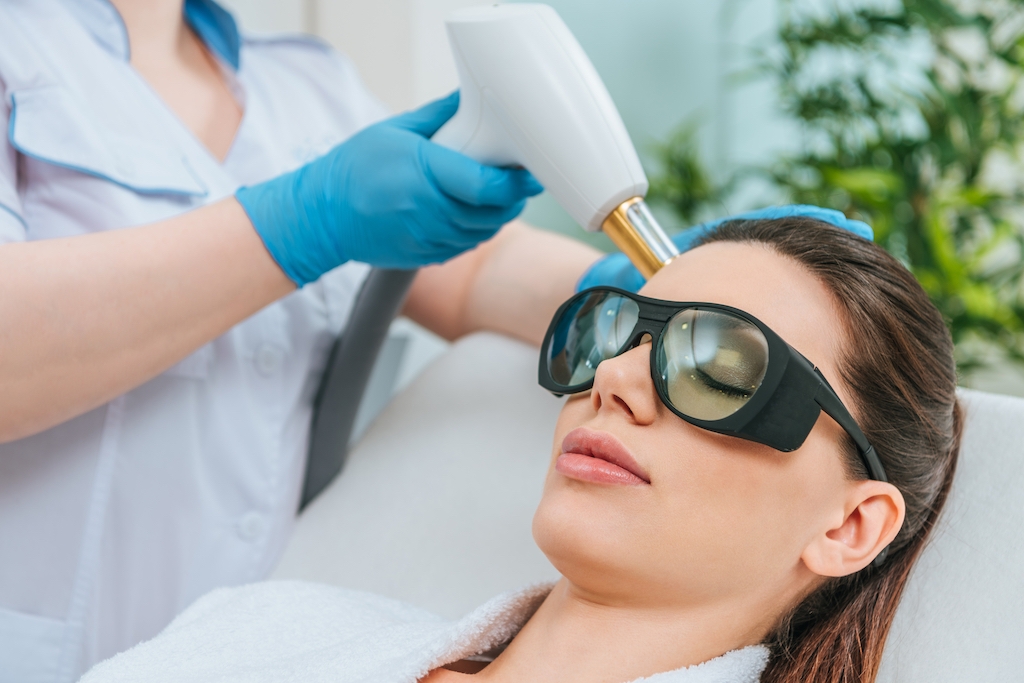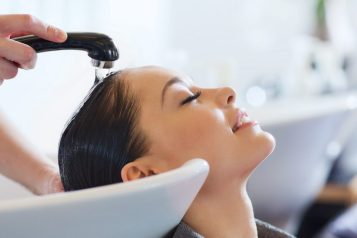Acne is a common skin condition that affects millions of people worldwide. But have you ever stopped to consider how acne scars form? While most people can manage their acne with over-the-counter treatments and good skincare habits, some people are left with unsightly scars.
When a person’s breakouts are severe or inflamed, acne scars form in the body’s efforts to repair the damage done. When the skin is damaged, the body produces collagen, a protein that helps to improve and heal the skin. However, in some cases, the body produces too much collagen, which can form scars.
There are two main types of acne scars, atrophic and hypertrophic. Here, Haute Beauty expert Dr. Cameron Rokhsar delves into the types of acne scars, how they develop, and the treatment options available to those looking to reduce the appearance of these scars.

Atrophic Scarring
Most acne causes atrophic scarring, which is classified by depressions or concavities in the skin. The areas most commonly affected by atrophic scars are your forehead, temple, cheeks, and the area around your jawline. Atrophic scarring is generally divided into three subcategories.
- Icepick scars: These are characterized by distinct, very deep, narrow depressions, which are less than 3mm in diameter but can be as small as 1mm. They are the most difficult type of acne scar to treat.
- Rolling scars: These are larger depressions, usually broad but shallow, that have a rolling or wave-like appearance. They are caused by a loss of collagen and elastin in the skin and are most common in the cheek area.
- Boxcar scars: The most common types of scars, which are often found on the cheeks and temples. This type of scarring can also be seen on the back and shoulders of individuals with severe acne. Boxed scars are shallow but wider than icepick scars.
Hypertrophic Scarring
Instead of depressions in the skin (atrophic scarring), one can experience the reverse, bumps in the skin (hypertrophic scarring). The most common area for hypertrophic scarring is on the nose and chin. There are also individuals who suffer from scarring on their shoulders, chest, and back.

Treatment Options
In general, acne scars are hard to treat. Thankfully, we have come a long way in terms of improving acne scar treatments and have been able to come up with distinct solutions for different forms of acne scarring.
Can over-the-counter creams treat scars?
No, this is a huge misconception. Since scars are surface irregularities, creams are unable to address them. Creams may only have a role in treating brown pigmentations associated with acne scars in darker-skinned individuals. The redness associated with acne scars cannot be treated with creams either.
Are there treatments that work best with a type of acne scar?
Laser resurfacing is the gold standard treatment for acne scars. There are several laser treatments that can be effective in treating the different types of acne scars. Dr. Rokhsar’s preferred laser resurfacing method is fractional laser resurfacing with the Fraxel laser.
Icepick scars are deep, narrow scars, that are typically difficult to treat with non-invasive methods, and one of the most effective ways to treat them is through a punch excision. Punch excision is a surgical procedure where Dr. Rokhsar will cut out the scar with a tool called a dermal punch. The skin is then closed with stitches. After the procedure, the scar will be closed with sutures. This transforms the icepick scar into a surgical scar, which allows Dr. Rokhsar to use a fractional laser resurfacing procedure a few weeks later to blend it in.
Rolling scars can be treated with a procedure called subcision. Subcision is a minimally invasive procedure that uses a small needle to release the fibrous bands that are pulling the skin down and creating a rolling appearance. Subcision is often combined with other treatments such as microneedling or fillers to enhance the results.
Hypertrophic scars need to be flattened first. This can be achieved through the injection of 5-fluorouracil (5FU) in combination with triamcinolone acetonide (TAC). The scar can then be treated with a pulse dye laser (PDL) therapy or fractional laser resurfacing.
Microneedling is a minimally invasive treatment that can help improve the appearance of acne scars. Dr. Rokhsar prefers laser resurfacing but microneedling can be helpful in combination with it.
Red scars can be treated with a variety of methods. The treatment of choice to decrease the redness in scars is the pulse dye laser (PDL). Multiple sessions may be needed to achieve the desired results.

Acne Prevention Methods
If your skin is prone to hyperpigmentation, it is important to take extra care of it to avoid acne scars. There are several daily acne prevention methods that can help you reduce the likelihood of developing new acne and improve the overall appearance of your skin.
- Practice good sun protection and wear at least SPF 30 every day. Avoid oily sunblocks as they can make you break out.
- Use gentle skincare products.
- Avoid picking or squeezing pimples that form, this can cause scarring.
- When it comes to preventing acne scars, stay consistent.
Once a scar forms, how long after should it be treated?
There is no reason to wait to treat acne scars. There is a multitude of studies that support the notion that fresh scars actually respond better to laser treatments. It is important that you have managed your acne properly so you no longer are breaking out with active acne at the time of treatment. Laser resurfacing can make some people break out more if the acne is not properly controlled prior to the treatment.
In the case that you were on Accutane, it is recommended to wait for one more before receiving any form of treatment. Though Accutane has been associated with poor healing in some reports, the medicine takes one month to leave your system. Some dermatologists do recommend waiting six months but this is overkill and not based on scientific fact or reason.
If you are looking to reduce the appearance and overall look of your acne scars, consult with Dr. Rokhsar today as there are plenty of options available to you.
























